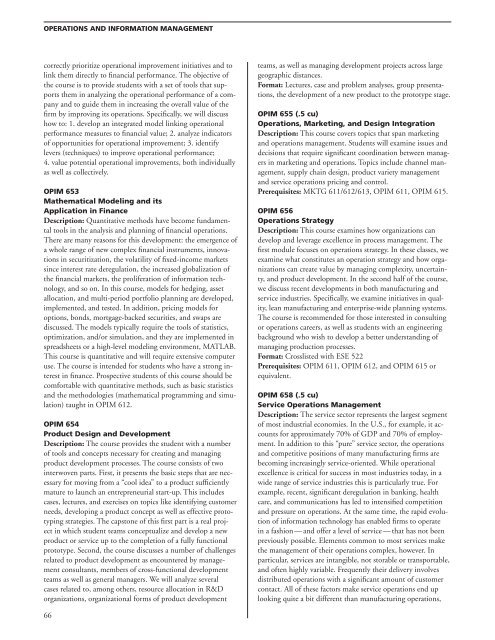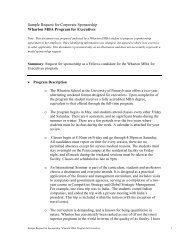Explore Options; Plan Your MBA Academic Program
Explore Options; Plan Your MBA Academic Program
Explore Options; Plan Your MBA Academic Program
You also want an ePaper? Increase the reach of your titles
YUMPU automatically turns print PDFs into web optimized ePapers that Google loves.
OPERATIONS AND INFORMATION MANAGEMENT<br />
correctly prioritize operational improvement initiatives and to<br />
link them directly to financial performance. The objective of<br />
the course is to provide students with a set of tools that supports<br />
them in analyzing the operational performance of a company<br />
and to guide them in increasing the overall value of the<br />
firm by improving its operations. Specifically, we will discuss<br />
how to: 1. develop an integrated model linking operational<br />
performance measures to financial value; 2. analyze indicators<br />
of opportunities for operational improvement; 3. identify<br />
levers (techniques) to improve operational performance;<br />
4. value potential operational improvements, both individually<br />
as well as collectively.<br />
OPIM 653<br />
Mathematical Modeling and its<br />
Application in Finance<br />
Description: Quantitative methods have become fundamental<br />
tools in the analysis and planning of financial operations.<br />
There are many reasons for this development: the emergence of<br />
a whole range of new complex financial instruments, innovations<br />
in securitization, the volatility of fixed-income markets<br />
since interest rate deregulation, the increased globalization of<br />
the financial markets, the proliferation of information technology,<br />
and so on. In this course, models for hedging, asset<br />
allocation, and multi-period portfolio planning are developed,<br />
implemented, and tested. In addition, pricing models for<br />
options, bonds, mortgage-backed securities, and swaps are<br />
discussed. The models typically require the tools of statistics,<br />
optimization, and/or simulation, and they are implemented in<br />
spreadsheets or a high-level modeling environment, MATLAB.<br />
This course is quantitative and will require extensive computer<br />
use. The course is intended for students who have a strong interest<br />
in finance. Prospective students of this course should be<br />
comfortable with quantitative methods, such as basic statistics<br />
and the methodologies (mathematical programming and simulation)<br />
taught in OPIM 612.<br />
OPIM 654<br />
Product Design and Development<br />
Description: The course provides the student with a number<br />
of tools and concepts necessary for creating and managing<br />
product development processes. The course consists of two<br />
interwoven parts. First, it presents the basic steps that are necessary<br />
for moving from a “cool idea” to a product sufficiently<br />
mature to launch an entrepreneurial start-up. This includes<br />
cases, lectures, and exercises on topics like identifying customer<br />
needs, developing a product concept as well as effective prototyping<br />
strategies. The capstone of this first part is a real project<br />
in which student teams conceptualize and develop a new<br />
product or service up to the completion of a fully functional<br />
prototype. Second, the course discusses a number of challenges<br />
related to product development as encountered by management<br />
consultants, members of cross-functional development<br />
teams as well as general managers. We will analyze several<br />
cases related to, among others, resource allocation in R&D<br />
organizations, organizational forms of product development<br />
66<br />
teams, as well as managing development projects across large<br />
geographic distances.<br />
Format: Lectures, case and problem analyses, group presentations,<br />
the development of a new product to the prototype stage.<br />
OPIM 655 (.5 cu)<br />
Operations, Marketing, and Design Integration<br />
Description: This course covers topics that span marketing<br />
and operations management. Students will examine issues and<br />
decisions that require significant coordination between managers<br />
in marketing and operations. Topics include channel management,<br />
supply chain design, product variety management<br />
and service operations pricing and control.<br />
Prerequisites: MKTG 611/612/613, OPIM 611, OPIM 615.<br />
OPIM 656<br />
Operations Strategy<br />
Description: This course examines how organizations can<br />
develop and leverage excellence in process management. The<br />
first module focuses on operations strategy. In these classes, we<br />
examine what constitutes an operation strategy and how organizations<br />
can create value by managing complexity, uncertainty,<br />
and product development. In the second half of the course,<br />
we discuss recent developments in both manufacturing and<br />
service industries. Specifically, we examine initiatives in quality,<br />
lean manufacturing and enterprise-wide planning systems.<br />
The course is recommended for those interested in consulting<br />
or operations careers, as well as students with an engineering<br />
background who wish to develop a better understanding of<br />
managing production processes.<br />
Format: Crosslisted with ESE 522<br />
Prerequisites: OPIM 611, OPIM 612, and OPIM 615 or<br />
equivalent.<br />
OPIM 658 (.5 cu)<br />
Service Operations Management<br />
Description: The service sector represents the largest segment<br />
of most industrial economies. In the U.S., for example, it accounts<br />
for approximately 70% of GDP and 70% of employment.<br />
In addition to this “pure” service sector, the operations<br />
and competitive positions of many manufacturing firms are<br />
becoming increasingly service-oriented. While operational<br />
excellence is critical for success in most industries today, in a<br />
wide range of service industries this is particularly true. For<br />
example, recent, significant deregulation in banking, health<br />
care, and communications has led to intensified competition<br />
and pressure on operations. At the same time, the rapid evolution<br />
of information technology has enabled firms to operate<br />
in a fashion — and offer a level of service — that has not been<br />
previously possible. Elements common to most services make<br />
the management of their operations complex, however. In<br />
particular, services are intangible, not storable or transportable,<br />
and often highly variable. Frequently their delivery involves<br />
distributed operations with a significant amount of customer<br />
contact. All of these factors make service operations end up<br />
looking quite a bit different than manufacturing operations,

















